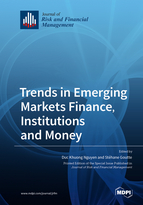Trends in Emerging Markets Finance, Institutions and Money
A special issue of Journal of Risk and Financial Management (ISSN 1911-8074). This special issue belongs to the section "Financial Markets".
Deadline for manuscript submissions: closed (31 December 2019) | Viewed by 68069
Special Issue Editors
2. VNU International School, Hanoi 100000, Vietnam
Interests: asset pricing; energy finance; financial economics; financial modeling
Special Issues, Collections and Topics in MDPI journals
Special Issue Information
Dear Colleagues,
In her recent speech at the University of Maryland, on 4 February 2016, Christine Lagarde, the Managing Director of International Monetary Fund, pointed out the increasing importance of emerging markets countries as a locomotive of the global growth (80% since the global financial crisis of 2008), job creations, poverty reduction and international trade activities. Together with other developing economies, they now contribute up to 60% of global GDP. However, emerging markets are still found to be vulnerable to external shocks, essentially due to their ongoing maturing institutions and increased financial tights with their developed counterparts. High exposure to decreases in capital outflows following a more-rapid-than-expected tightening of the US monetary policy is another reason that could challenge economic growth and financial development of emerging markets.
This Special Issue will dedicate special attention to the current dynamics of emerging financial markets, as well as their perspectives of development as a key driver for sustainable firms and economies. Accordingly, the focus is particularly placed on market integration and interdependence, valuations and risk management practices, and the financing means for inclusive growth.
Topics of interest include, but are not limited to:
- Financial markets and efficiency
- Asset pricing models
- Sustainable finance
- Cost of capital in emerging markets
- Determinants of saving and investment
- Capital flows
- Exchange rate volatility
- Sovereign risks
- Policy uncertainty and financial risk
- Stock market co-movement and contagion
- Cross-border investments
Prof. Dr. Stéphane Goutte
Guest Editors
Manuscript Submission Information
Manuscripts should be submitted online at www.mdpi.com by registering and logging in to this website. Once you are registered, click here to go to the submission form. Manuscripts can be submitted until the deadline. All submissions that pass pre-check are peer-reviewed. Accepted papers will be published continuously in the journal (as soon as accepted) and will be listed together on the special issue website. Research articles, review articles as well as short communications are invited. For planned papers, a title and short abstract (about 100 words) can be sent to the Editorial Office for announcement on this website.
Submitted manuscripts should not have been published previously, nor be under consideration for publication elsewhere (except conference proceedings papers). All manuscripts are thoroughly refereed through a single-blind peer-review process. A guide for authors and other relevant information for submission of manuscripts is available on the Instructions for Authors page. Journal of Risk and Financial Management is an international peer-reviewed open access monthly journal published by MDPI.
Please visit the Instructions for Authors page before submitting a manuscript. The Article Processing Charge (APC) for publication in this open access journal is 1400 CHF (Swiss Francs). Submitted papers should be well formatted and use good English. Authors may use MDPI's English editing service prior to publication or during author revisions.
Keywords
- Valuation models
- Risk sharing and management
- Financial integration
- Sustainable finance
- International investments
- Capital mobility






